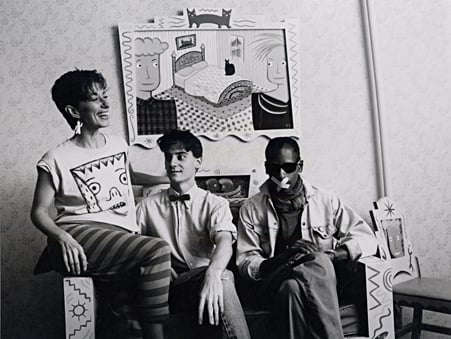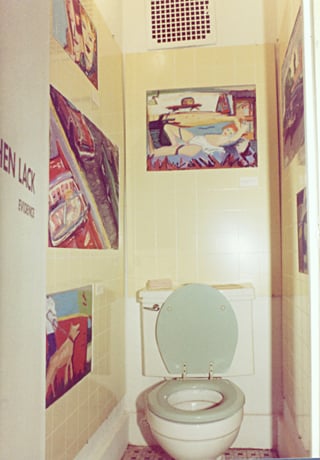Galleries
East Side Story: Remembering the 1980s East Village Art Scene
Gracie Mansion recalls the vibrant East Village art scene of the 1980s.

Gracie Mansion recalls the vibrant East Village art scene of the 1980s.

Gracie Mansion

In the mid-1970s, I worked at a law collective, while attending art school and living in a commune in New Jersey. During that time, I befriended Al Hansen (American, 1927–1995), who was then teaching at Rutgers. On trips to New York, Al introduced me to many artists, including Sur Rodney (Sur), who had curated a show at his brother’s gallery in Soho. After graduation, I moved to the East Village, where I re-connected with Sur, who was doing pre-production for his video entitled The All-New Sur Rodney (Sur) Show. At the time, I worked at a print gallery in Soho, and started selling friends’ artwork. Sur also worked there. He and I curated a show in a two–foot access space behind the display windows, hanging artwork from coat hangers.

© Andreas Sterzing, The Nuclear Family, 1983 From left to right: Gracie Mansion, Rodney Greenblat, and Sur Rodney (Sur).
In 1981, Buster Cleveland (American, 1943–1998) and I set up one-night shows of his collages in Jim Stark’s loft. Then we came up with the “Limousine Show,” for which we rented a limo and parked it on the corner of Spring and West Broadway in the hopes of encountering Leo Castelli on his daily route. Unfortunately, Castelli was just passing as we pulled up. I sold collages from the backseat, while Sur offered cherries from a silver tray on the sidewalk. During this time, I also participated in a number of themed shows at Club 57. The work would be brought to the basement of a church at 57 Saint Mark’s Place, where it would hang for one night. These works were then retrieved after midnight.
It seemed to be a time of no limitations. Everything was possible; more than that, it was probable. Around this time, I started using the name Gracie Mansion. In my fifth-floor walk-up, with a bathtub in the kitchen and a tiny room for the loo, I had hung a selection of photographs that Timothy Greathouse had given me. In 1982, I offered to present them in the loo. He loved the idea, and I set about designing a letterhead for the new Gracie Mansion Gallery, Loo Division. The press release had the show running for one night, with access “by appointment” for the rest of the month—one–at–a–time viewing in an intimate setting.

Gracie Mansion Gallery, Loo Division
When Howard Smith and Melik Kaylan interviewed me for a Village Voice article, they asked me about my next show. I couldn’t admit that it was a one-time event. By the third show, my landlord put a stop to it. Paul McGregor offered me a former hair salon above his bar on Saint Mark’s Place, where I worked as a cocktail waitress. I renamed the gallery Gracie Mansion Gallery, Lieu Division and organized three shows there: Beyond the American Standard, The Famous Show, and a solo show of Carmen Cicero’s paintings.
I then found a space on 10th Street facing Tompkins Square Park. Sur agreed to help and Jim Stark agreed to buy enough artwork to pay the rent (US$500 a month) for a year. We opened with East Village Art: Food for Thought, a fundraiser for the new gallery, now simply called the Gracie Mansion Gallery. I still worked in Soho three days a week and Sur would come to the gallery after he got off work at Saint Mark’s Graphics at 5:00. Every month we painted the gallery a new color.
Each show was a transformation. The East Village was teeming with artists. In fact, all of the earliest gallery owners were artists as well. We attended each other’s openings and sent curators and collectors to each other’s shows. Carlo McCormick and Walter Robinson covered it all in Leonard Abrams’s East Village Eye. We traveled en masse to art fairs and out-of-town exhibitions. Limbo Lounge and 8BC were our private clubs. We even started a “Girls” Night Out, when the female artists, curators, and gallerists would party together.
In 1983, my gallery expanded to the storefront next door. I then had an East and West Gallery, as well as a backyard (a third exhibition space). In 1984, we moved to a larger space on Avenue A. and Greathouse took over the West Gallery. In the East Gallery, we opened the Gracie Mansion Museum Store, which was run by Elayne Kling and sold mostly functional objects by the neighborhood artists. I thought the store would help support the gallery, but it actually lost money from day one.
In 1985, the artist Nicolas Moufarrege died of AIDS, a disease that would take the community by storm. When the Fun Gallery closed in 1987, someone spray-painted “The Fun Is Gone” on the outside of their building. That said it all. By 1989, Sur had left and I finally gave in; my gallery was one of the last to move to Soho.
Upon Timothy Greathouse’s death, 8BC owner Cornelius Conboy said something that moves me to this day: “I thought of…how anything was possible and how clear the future lay in front of us. We knew nothing of the impending plague and thought that those halcyon days (and nights) would be the defining moments of our lives. How wonderfully naïve we were.”